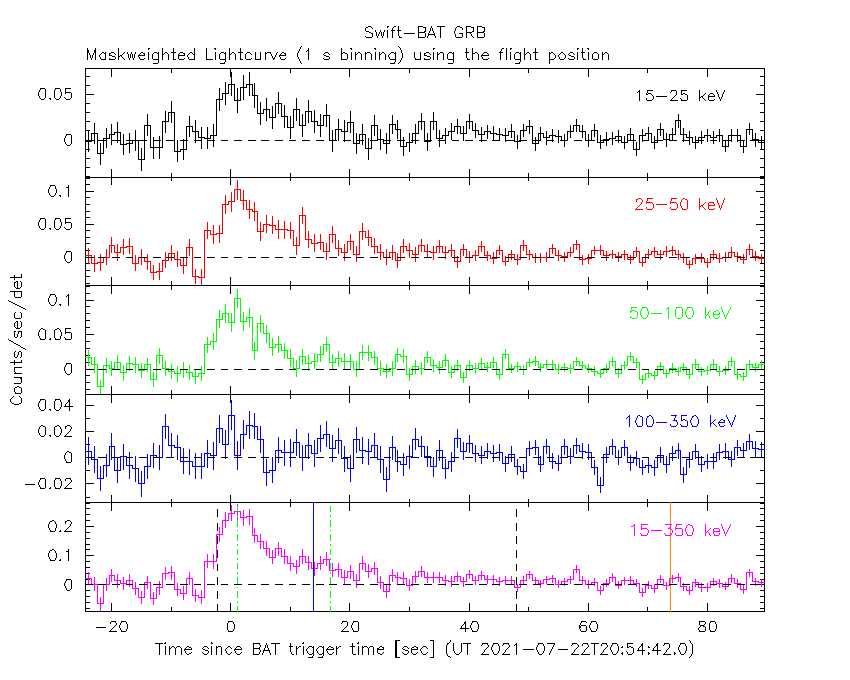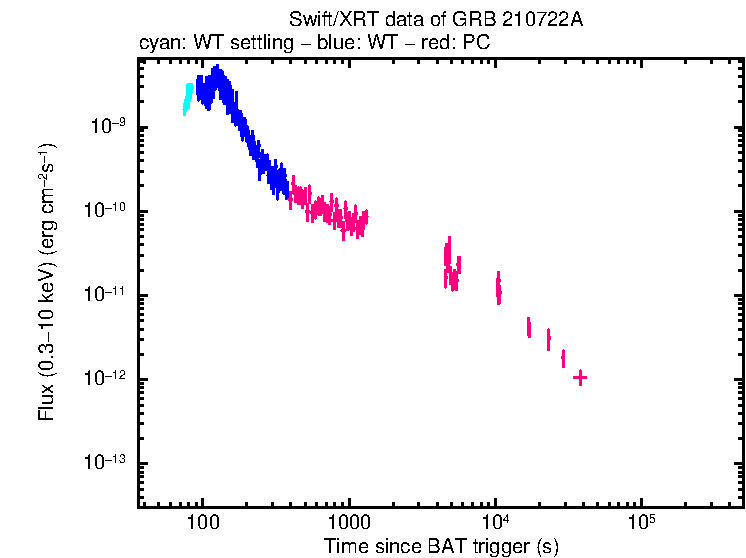
P. D'Avanzo (INAF-OAB), K.L. Page (U. Leicester) and M.H. Siegel (PSU) for the Swift team
At 20:54:42 UT, the Swift Burst Alert Telescope (BAT) triggered and located GRB 210722A (trigger=1061223) (D'Avanzo et al. GCN Circ. 30475). Swift slewed immediately to the burst. At the time of the trigger, the initial BAT position was 97° from the Sun (6.3 hours West) and 98° from the 98%-illuminated Moon. Table 1 contains the best reported positions from Swift, and the latest XRT position can be viewed at http://www.swift.ac.uk/xrt_positions.
D'Avanzo et al. (GCN Circ. 30475) reported the discovery with UVOT of an optical afterglow. Thoene et al. (GCN Circ. 30487) determined a redshift of 1.145 from GTC. Table 2 is a summary of GCN Circulars about this GRB from observatories other than Swift.
Standard analysis products for this burst are available at https://gcn.gsfc.nasa.gov/swift_gnd_ana.html.
As reported by Barthelmy et al. (GCN Circ. 30489),
the BAT ground-calculated position is RA, Dec = 27.031, -6.347 deg which is RA(J2000) = 0
The mask-weighted light curve (Figure 1) shows a single-peaked structure that starts at ~T-5 s, peaks at ~
The time-averaged spectrum from T-4.40 to T+59.59 s is best fit by a simple power-law model.
The power law index of the time-averaged spectrum is 1.62 ± 0.14.
The fluence in the 15-150 keV band is 2.5 ± 0.2 x 1
The results of the batgrbproduct analysis are available at https://gcn.gsfc.nasa.gov/notices_s/1061223/BA/.
Analysis of the initial XRT data was reported by Page et al. (GCN Circ. 30483). We have analysed 6.3 ks of XRT data for GRB 210722A, from 91 s to 47.1 ks after the BAT trigger. The data comprise 294 s in Windowed Timing (WT) mode with the remainder in Photon Counting (PC) mode.
The late-time light curve (Figure 2) (from T0+4.5 ks) can be modelled with a power-law decay with a decay index of α=1.31 (+0.10, -0.09).
A spectrum formed from the WT mode data can be fitted with an absorbed
power-law with a photon spectral index of 2.20 ± 0.05. The
best-fitting absorption column is 4.2 (+1.0, -0.9) x 1
The Swift/UVOT began settled observations of the field of GRB 210722A 94 s after the BAT trigger
(Siegel and D'Avanzo GCN Circ. 30482).
A source consistent with the XRT position is detected in the initial UVOT exposures.
Table 3 gives preliminary
magnitudes using the UVOT photometric system
(Breeveld et al. 2011, AIP Conf. Proc., 1358, 373).
No correction has been made for the expected extinction in the Milky Way
corresponding to a reddening of

Figure 1. The BAT
mask-weighted light curve in the four individual and total
energy bands. The units are counts

Figure 2. The XRT light curve.
Any data from a crosshatched region are not included in the fit.
| RA (J2000) | Dec (J2000) | Error | Note | Reference |
|---|---|---|---|---|
| 0 |
-06°20'49.7" | 0.42" | UVOT-refined | Siegel and D'Avanzo GCN Circ. 30482 |
| 0 |
-06°20'51.3" | 1.4" | XRT-final | UKSSDC |
| 0 |
-06°20'51.3" | 2.0" | XRT-refined | Page et al. GCN Circ. 30483 |
| 0 |
-06°20'49.9" | 1.2' | BAT-refined | Barthelmy et al. GCN Circ. 30489 |
| Band | Authors | GCN Circ. | Subject | Observatory | Notes |
|---|---|---|---|---|---|
| Optical | Zhu et al. | 30476 | Nanshan/NEXT optical afterglow observations |
Xinjiang Astro. Obs. | detection |
| Optical | Pankov et al. | 30478 | Assy optical detection | Assy-Turgen Obs. | detection |
| Optical | Lipunov et al. | 30480 | Swift GRB 210722A: Global MASTER-Net observations report |
MASTER | |
| Optical | Kumar et al. | 30481 | GIT optical detection and preliminary analysis |
GROWTH-India Tel. | detection |
| Optical | Butler et al. | 30484 | RATIR Optical Observations | RATIR | |
| Optical | Thoene et al. | 30487 | Redshift from OSIRIS/GTC | GTC | redshift |
| Optical | Pankov et al. | 30488 | Kitab optical observations, light curve | light curve | |
| Optical | Jelinek et al. | 30492 | D50 optical detection | D50 | detection |
| Optical | Pankov et al. | 30494 | continued Assy optical observations | Assy-Turgen Obs. | detection |
| Optical | Fu et al. | 30504 | Nanshan/NEXT further optical observations |
Xinjiang Astro. Obs. | |
| Optical | Kim et al. | 30505 | continued Assy optical observations | Assy-Turgen Obs. | detection |
| Optical | Klotz et al. | 31754 | TAROT Reunion observatory optical light curve |
TAROT | light curve |
| Gamma-ray | Wood | 30490 | Fermi GBM observation | Fermi GBM | Fluence=5.8±0.6x1 (brighter than 61% of long GRBs) |
| Filter | Exp(s) | Mag | ||
|---|---|---|---|---|
| white | 94 | 244 | 147 | 14.31 ± 0.02 |
| v | 637 | 656 | 19 | 14.52 ± 0.06 |
| b | 563 | 583 | 20 | 14.65 ± 0.04 |
| u | 308 | 557 | 246 | 13.68 ± 0.02 |
| w1 | 686 | 705 | 20 | 14.08 ± 0.06 |
| w2 | 4908 | 4971 | 62 | 17.08 ± 0.14 |
Table 3. UVOT observations reported by Siegel and D'Avanzo (GCN Circ. 30482). The start and stop times of the exposures are given in seconds since the BAT trigger. The preliminary detections and 3-σ upper limits are given. No correction has been made for extinction in the Milky Way.
March 14, 2022